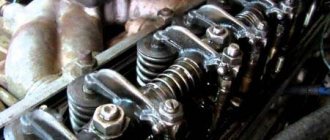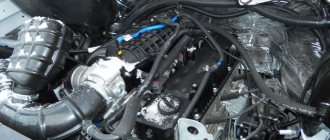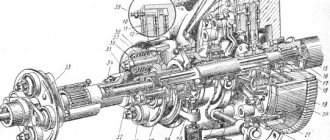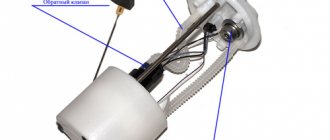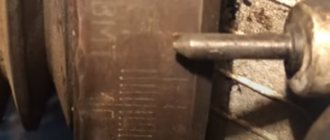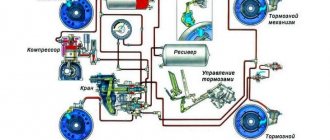Drivers are often interested in how to adjust the valves on the 4216 Gazelle engine. Which is quite understandable. This malfunction leads to increased fuel consumption. And since Gazelles are usually used for commercial purposes, this automatically negatively affects the cost per kilometer.
Also, incorrect clearance leads to increased wear of the gas distribution mechanism elements.
In addition, clamping the valves leads to improper engine operation and loss of power. Thus, adjustment work should be carried out at the slightest sign of a problem. It's good if you do it yourself. After all, not every service has people who know how to do this work correctly. How to adjust valves on a 4216 Gazelle engine?
In fact, this work is not difficult. But it's important to do everything right. To do this, you need to know the signs of incorrect valve settings and some features of the 4216 engine. The main sign of a malfunction is increased engine noise and misfire of the cylinders. At the same time, rhythmic, rather ringing knocks will be heard. Also, along with this, increased fuel consumption and/or engine tripping may occur. All this indicates the need to adjust the valves. It should be taken into account that the working stroke of the cylinders is 1-2-4-3. Do not forget that the clearances in the exhaust valves of cylinders 1 and 4 will be approximately 0.5 mm less.
Preparation
Setting up valves is quite a complex and responsible job. Therefore, before this action, you must prepare the car. First you need to securely secure the car. In addition to the handbrake, you also need to use wheel chocks. Next, we leave Gazelle for several hours. This is necessary to ensure that the engine cools down properly. More specifically, the time must be calculated based on temperature conditions. On the injector, access to the valves is easier; on the carb, you will have to tinker. The air filter is removed. Here you will have to tinker. Work should begin by removing the air vent cover, after which the fastening nuts are unscrewed. The hose of the vacuum ignition distributor and the breather pipe are dismantled. The throttle and air damper linkages must be disconnected from the carburetor, otherwise they will interfere. The valve cover is unscrewed. This completes the preliminary stage.
GAZ 31 2002, 92 l. With. — self-repair
Comments 12
Thank you, it was useful. In the book, the adjustment is carried out in 4 turns of 180′, but here it turns out that it’s possible in 2))
thumbs up with both hands! I adjusted the valve like this, the engine just whispers =) I drove for two days without a tape recorder =)) I listened to the engine! =))
I also posted the code at ZMZ to assemble the engines, everyone there does it on both 511 and 513
The last time I adjusted the valves using this scheme. I've already driven 4000 km, the flight is normal! I drive gas and 95.
This is interesting: Replacing the Gazelle rear axle oil seal
So I drove after such an adjustment and everything was fine.
Obviously this is not according to the book. I agree that you should use it, but not completely trust it, because... Only then was I able to set the valves to a rustling state when I reduced ALL values by 0.05, BUT I still did it according to the book, that is, after adjusting the valves of EACH piston, I rotated the crankshaft by 180. This is where I disagree, because I tried to adjust two pistons at once, but one at a time is mandatory!
Anything is possible, but I did it according to this scheme, everything worked with a bang, I couldn’t hear the valves.)))
Obviously this is not according to the book. I agree that you should use it, but not completely trust it, because... Only then was I able to set the valves to a rustling state when I reduced ALL values by 0.05, BUT I still did it according to the book, that is, after adjusting the valves of EACH piston, I rotated the crankshaft by 180. This is where I disagree, because I tried to adjust two pistons at once, but one at a time is mandatory!
Based on the book! There is this method in the murzilka attached to the car!
I didn't have it written in the book.
I adjusted it literally a month ago, so I couldn’t have made a mistake) It’s not a fact that the books are the same)
Adjustment
All work must be carried out to the highest possible quality. To do this, it is advisable to consult an experienced mechanic. It would be good if he supervises the execution of the work. It should be noted that valve adjustment on the 4216 engine can only be performed when the engine temperature is 15-20°C, no more. If the car has been driven before, you need to let it cool for 1.5 hours. Otherwise, the gap will be greater than the specified one by about 0.1 mm - and this is quite a lot. The adjustment is made in the following order: 1
. The first cylinder should be set to top dead center using a ratchet wrench at the mark. To do this, you will need to unscrew the candle and plug the hole with a plastic bag. When it is knocked out of the engine, it means that TDC is close. You need to bring the piston to the top, controlling its position with a screwdriver. In theory, TDC should coincide with the third mark on the crankshaft pulley. The engine is turned strictly clockwise using a ratchet wrench; How to set up the ignition on the UMZ 421 can be found here.
2
. In this position, the valves of the first cylinder are closed. Therefore, we check the gaps on them, select the appropriate probes and insert them into the gap. We make the gap for the intake and exhaust valves 0.35 mm. - this has been tested - it works perfectly! If everything is in order, then the probe should enter with slight effort. If it passes easily or does not fit, then you need to make adjustments. To do this, loosen the lock nut and, holding it with a wrench, rotate the screw, adjusting the valve clearance 1.2.4.6. After adjustment, be sure to tighten the locknut;
3
.
The crankshaft is rotated 180°, in this position valves 3.5.7.8 are adjusted; 4
.
Turn the engine over again, also 180°, and check the clearance. 5
.
After this you need to repeat the check. This will guarantee that the work is completed correctly; 6
. Perform final assembly, installing all removed parts in place.
Technical features
How to adjust valves on a 4216 Gazelle engine? In fact, this work is not difficult. But it's important to do everything right. To do this, you need to know the signs of incorrect valve settings and some features of the 4216 engine.
The main sign of a malfunction is increased engine noise and misfire of the cylinders. At the same time, rhythmic, rather ringing knocks will be heard.
Also, along with this, increased fuel consumption and/or engine tripping may occur. All this indicates the need to adjust the valves.
It should be taken into account that the working stroke of the cylinders is 1-2-4-3. Do not forget that the clearances in the exhaust valves of cylinders 1 and 4 will be approximately 0.5 mm less.
Video on adjusting valve clearances on Gazelle UMZ 4216
If you don’t want to adjust the valves every season, then we have invented for you a set of gas distribution mechanism parts for the UMZ 4216 engine, modification of the ZMZ series 402,4026. Set of rods with hydraulic compensators for UMZ 4216 GAZ 3302 article 21-1007175-GK. For cars GAZelle 3302, Gazelle Business Engine UMZ-4216. The use of rods with hydraulic compensators made it possible to avoid adjusting the clearances of the valve mechanism and make its operation “softer”; significantly reduce shock loads, that is, reduce wear on timing parts and eliminate increased engine noise; more accurately observe the duration of the valve timing, which has a positive effect on the safety of the engine, its power and fuel consumption. Advantages
• Maintenance-free - no gap occurs during the entire service life of the engine; • Low noise - the engine noise level is reduced, since the noise-producing valve clearance is reduced; • Resistant to high speeds - the design of the hydraulic compensators ensures the possibility of long-term engine operation at high speeds; • Durable - the degree of wear is reduced, since a rigid kinematic chain is always provided between the timing parts, constantly ensuring a low valve seating speed; • Environmentally friendly - structurally optimized engine valve timing, and therefore exhaust gas composition indicators, remain virtually unchanged throughout the entire service life and in all engine operating modes.
Why do you need to adjust valves?
If suddenly there is extraneous noise when the engine is running, then most likely you will have to check the engine or valves. Gazelle diagnostics:
- It is best to do the inspection using a stethoscope; the K-69M GARO model is suitable for this case.
- In this case, the gazelle engine must be warmed up, and it must be checked at different crankshaft speeds.
- You will have to listen carefully at the lowest speed, then at the middle one, starting with the distribution mechanism, and then checking the operation of the valves (750-1000 rpm).
Sounds from damaged valves are heard best in the place where the head is located, above their locations.
Disassembled engine 4216
But if the sounds are too loud and they come from the valves or pushrods, or if the crankshaft speed increases and these sounds merge into a general hum, then the engine is fine.
Types of hydraulic compensators
Types of hydraulic compensators may differ depending on their installation location and timing layout. In connection with these parameters, devices can be:
- Hydraulic pushers;
- Hydro supports;
- Roller hydraulic pushers;
- Hydraulic supports installed under rocker arms and levers.
Despite the fact that all types of hydraulic compensators have differences in design, they still basically have the same operating principle. The most common are hydraulic pushers with a flat support under the camshaft cam. Such mechanisms are installed on the valve stem and then the camshaft cam acts directly on the hydraulic tappet.
Learn more about the design of the hydraulic compensator in this video:
Published: November 13, 2020
What is a hydraulic compensator?
Hydraulic compensators are considered to be the most reliable devices, the functional task of which is to adjust the thermal valve clearances. In situations where the operating conditions of the hydraulic compensators fully meet the requirements, the driver does not have to worry about anything - all the work will be done without his participation.
The hydraulic compensator is a unit, the basis of which is a body and a plunger. The installation location of this element is the space between the camshaft cams and valves. They adjust the gaps constantly at the moment the cams are pressed using oil poured into the engine. This process can be described as follows: when the cam begins to move, the hydraulic compensator housing moves downward, coaxially connecting its oil channel with the common cylinder head channel. Under the influence of the oil entering the plunger, it is pushed out of the housing seat, as a result of which it occupies the free space located between the cams and the valve end part. As a result of the resulting pressure, the oil inside the housing is clogged with a special ball valve. The thermal gap is reduced to minimum values, and the cylinder head valve opens. Return to the original positions occurs by opening the ball valve, as a result of which excess oil is discharged, which helps to restore the required clearance.
The action of the hydraulic compensator is cyclical. It is repeated every time the cams begin to press. We cannot fail to note the role of engine oil, which allows it to perfectly cope with the tasks emanating from the hydraulic compensator due to the low compression ratio.
Setting up after disassembling the unit
After repairing the GAZ, the valves need to be adjusted again. The sequence of manipulations is the same, however, a preliminary run-in of the engine is necessary - drive 50 kilometers before tuning.
The purpose of running in GAZ is to:
- the oil is distributed throughout the engine sections;
- gaskets are seated;
- The operation of the spark plugs or connecting rod mechanism was checked.
If the running-in results indicate that the engine is in full service, you can adjust the valves. If the settings are lost, the reason may be:
- in problems with the crankshaft;
- timing faults;
- damage to the cylinder block;
- incompetent driving.
Adjustment is not required for those vehicles whose engines are equipped with a hydraulic compensator.
Video on the topic: Adjusting valves UMZ 4216
Source
Why do you need a hydraulic compensator?
In old Zhiguli cars, the gas distribution mechanism drive and worn parts are usually noisy. The noise may appear periodically and disappear after the engine warms up, and this is a clear sign that not everything is in order with the thermal clearances in the cylinder head.
In principle, what problems, we adjusted the gaps and moved on, but the design of the gas distribution mechanism has gone far ahead since the appearance of the Fiat 124 engine in the late 50s, and the design muse illuminated the AvtoVAZ design bureau only in the 80s, half a century after how hydraulic compensators have already been actively used all over the world.
Preparatory operations
Despite the fact that adjusting the valves of the 4216 Gazelle engine is relatively simple, you need to understand that the process is very responsible. Before adjustment work, the machine should be carefully prepared.
The first thing you need to do is secure the car. The handbrake alone should not be trusted. It is better to additionally secure yourself with wheel chocks. Then, if the engine is hot, it is allowed to cool. The engine must be completely cold.
Before starting work, you need to get to the valve mechanism. This is relatively easy to do on injection engines, but more difficult on carburetor engines.
First you need to remove the air filter:
- First of all, remove the filter cover, then unscrew the fastening nuts.
- The hose of the vacuum ignition corrector and the breather pipe are also removed.
- Next, disconnect the rods from the carburetor - they will greatly interfere.
- Finally, the valve cover is unscrewed.
At this point, the preparatory work is completed and you can proceed directly to adjusting the valves of the 4216 Gazelle engine.
Reasons for changing the gap size in the valve system
It should be noted that the adjustment consists of establishing a certain fixed gap between the rocker arm and the valve. Its value can change quite quickly. The following problems are considered to be the causes of such unwanted deviations:
In addition to the listed engine malfunctions, the cause of the floating gap may be the behavior of the driver behind the wheel of the Gazelle. Extremely aggressive driving, such as rapid clutch release, for example, can lead to premature wear of functional components.
